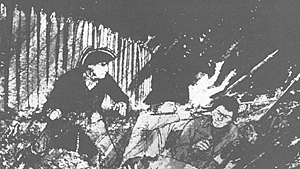 Young George Washington had been in the Ohio Valley earlier in the winter of 1753-54 on a mission for Governor Dinwiddie of Virginia. Major Washington's errand was to deliver notices of trespass to the French who were building forts in what was considered by the British to be their sovereign territory. The French were courteous to Washington but the letter written by Captain Legardeur de Saint-Pierre, the ranking French officer in the area, to Governor Dinwiddie, made itclearth at the French also claimed the Ohio Valley and would fight for it if necessary.
Young George Washington had been in the Ohio Valley earlier in the winter of 1753-54 on a mission for Governor Dinwiddie of Virginia. Major Washington's errand was to deliver notices of trespass to the French who were building forts in what was considered by the British to be their sovereign territory. The French were courteous to Washington but the letter written by Captain Legardeur de Saint-Pierre, the ranking French officer in the area, to Governor Dinwiddie, made itclearth at the French also claimed the Ohio Valley and would fight for it if necessary.
The Virginians were inadequately protected by low earthworks from French musketry. Courtesy of the National Park Service. Theme Editor: Bill Protz.
The stage was set for the opening of a conflict that would not only determine the fate of the Ohio Valley, but also the future of most of North America, India, and a large part of Europe.
Governor Dinwiddie was not about to give up any territory claimed by Britain to the French. He used his authority as commander-in-chief of the colony to call up the militia to repel the French invasion. Washington was promoted to Lt. Colonel and given command of whatever volunteers could be raised for an expedition to stop the French.
On the morning of April 2,1754, Washington with his band of between 130 and 160 men (accounts differ) left Alexandria, Virginia for the forks of the Ohio, where present day Pittsburgh stands as the Monongahela River joins the Allegheny River to form the Ohio River. In 1754 the site was occupied by Fort Duquesne, the furthermost French intrusion into "British" territory.
Washington probably looked splendid in his Virginia militia officer's uniform consisting of a red coat with white lace cuffs, red vest and trousers, polished blackboots, and the typical black, three-cornered hat. He is said to have selected the best horse in his stable as his personal mount for the campaign.
As far as can be determined his troops left much to be desired. Very few had even seen an Indian let alone fought them. Most were farmers and townspeople from civilized Virginia. They were not frontiersmen. The most common weapon was the smoothbore" Brown Bess" musket with an effective range of about sixty yards. Rifles were a rarity. It would be an understatement to say that they were not experts with their weapons. Some of the men were in the regular uniform of the Virginia militia but most had bits and pieces, of uniform combined with their civilian clothes.
Washington's immediate task was to take his troops into the Ohio Valley as far as he could, improving the road as they traveled, and set up a forward base to receive the expected reinforcements of 100 additional Virginians, 350 men from North Carolina, 200 from Maryland, two companies from New York, and an Independent company from South Carolina. Independent companies were trained and paid as British regulars and their officers held commissions from the King but they were not part of any regular British regiment. Pennsylvania, with its assembly being controlled by pacifist Quakers, would not contribute troops but did authorize funding to purchase food for the volunteers.
When assembled the total British force was expected to number more than 800 men. They were to attack and capture Fort Duquesne. Subsequent events postponed the capture of the French strongpoint for several years.
More Rid the Ohio of the French
Back to Table of Contents -- Courier Vol. VIII No. 3
To Courier List of Issues
To MagWeb Master Magazine List
© Copyright 1988 by The Courier Publishing Company.
This article appears in MagWeb (Magazine Web) on the Internet World Wide Web.
Other military history articles and gaming articles are available at http://www.magweb.com